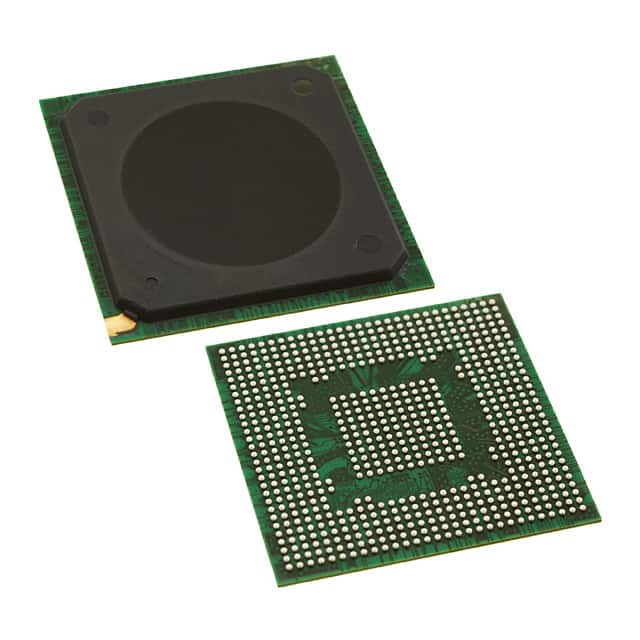MPC8379CVRANG
Product Overview
Category
MPC8379CVRANG belongs to the category of integrated circuits (ICs).
Use
This product is primarily used in embedded systems and networking applications.
Characteristics
- High-performance PowerQUICC II Pro processor
- Integrated security engine for enhanced data protection
- Support for various communication protocols
- Low power consumption
- Compact package size
Package
MPC8379CVRANG is available in a compact and durable package, suitable for surface mount technology (SMT) assembly.
Essence
The essence of MPC8379CVRANG lies in its ability to provide efficient processing power and advanced security features for embedded systems and networking applications.
Packaging/Quantity
MPC8379CVRANG is typically packaged in reels or trays, with a quantity of 250 units per reel/tray.
Specifications
- Processor: PowerQUICC II Pro
- Clock Speed: Up to 800 MHz
- Memory: DDR2/DDR3 SDRAM support
- Interfaces: Ethernet, USB, UART, SPI, I2C, PCI Express
- Security Features: Cryptographic acceleration, secure boot, tamper detection
- Operating Temperature Range: -40°C to +105°C
Detailed Pin Configuration
The pin configuration of MPC8379CVRANG is as follows:
- VDD_CORE
- VDD_PLL
- VDD_DDR
- VDD_PCI
- VDD_IO
- GND
- RESET
- CLKIN
- CLKOUT
- TDI
- TDO
- TMS
- TCK
- IRQ
- ...
(Note: The complete pin configuration table can be found in the product datasheet.)
Functional Features
- High-performance processing capabilities
- Advanced security features for data protection
- Support for multiple communication protocols
- Flexible memory options
- Low power consumption for energy-efficient operation
Advantages and Disadvantages
Advantages
- Powerful processing capabilities
- Enhanced security features
- Wide range of communication interfaces
- Compact package size
- Low power consumption
Disadvantages
- Relatively high cost compared to some alternative models
- Limited availability in certain regions
Working Principles
MPC8379CVRANG operates based on the PowerQUICC II Pro architecture, which combines a high-performance processor with integrated security features. The processor executes instructions and manages data flow, while the security engine ensures the protection of sensitive information.
Detailed Application Field Plans
MPC8379CVRANG finds applications in various fields, including: 1. Network routers and switches 2. Industrial automation systems 3. Telecommunications equipment 4. Embedded computing devices 5. Automotive electronics
Detailed and Complete Alternative Models
- MPC8378CVRAJD: Similar to MPC8379CVRANG but without the integrated security engine.
- MPC8377CVRAJF: Lower-cost variant with reduced processing power and fewer communication interfaces.
- MPC8376CVRAJH: Entry-level model with basic functionality and lower clock speed.
(Note: For a comprehensive list of alternative models, refer to the product catalog or consult the manufacturer's website.)
In conclusion, MPC8379CVRANG is a high-performance integrated circuit designed for embedded systems and networking applications. With its powerful processor, advanced security features, and support for various communication protocols, it offers a reliable solution for demanding industrial and telecommunications environments. While it may have a higher cost compared to some alternatives, its performance and feature set make it a preferred choice for many applications.
قم بإدراج 10 أسئلة وإجابات شائعة تتعلق بتطبيق MPC8379CVRANG في الحلول التقنية
Sure! Here are 10 common questions and answers related to the application of MPC8379CVRANG in technical solutions:
Q: What is MPC8379CVRANG? A: MPC8379CVRANG is a highly integrated system-on-chip (SoC) designed for networking applications, offering advanced features such as multiple Ethernet ports, USB interfaces, and high-performance processing capabilities.
Q: What are the key features of MPC8379CVRANG? A: The key features of MPC8379CVRANG include a Power Architecture e300 core running at up to 800 MHz, integrated DDR2/3 memory controller, Gigabit Ethernet ports, USB 2.0 interfaces, PCI Express, and various other peripherals.
Q: What are the typical applications of MPC8379CVRANG? A: MPC8379CVRANG is commonly used in networking equipment such as routers, switches, gateways, and industrial control systems that require high-speed data processing and connectivity.
Q: Can MPC8379CVRANG support real-time operating systems (RTOS)? A: Yes, MPC8379CVRANG can support various RTOS options, including VxWorks, QNX Neutrino, and Linux with real-time patches, making it suitable for time-critical applications.
Q: How many Ethernet ports does MPC8379CVRANG support? A: MPC8379CVRANG supports up to four Gigabit Ethernet ports, allowing for high-speed network connectivity.
Q: What is the maximum memory capacity supported by MPC8379CVRANG? A: MPC8379CVRANG supports up to 2 GB of DDR2/3 memory, providing ample space for data storage and processing.
Q: Can MPC8379CVRANG handle encryption and security protocols? A: Yes, MPC8379CVRANG includes hardware acceleration for encryption algorithms such as AES, DES, and SHA-1/SHA-256, enabling secure communication in network applications.
Q: Does MPC8379CVRANG support virtualization? A: Yes, MPC8379CVRANG supports hardware virtualization technologies like hypervisors, allowing for the efficient utilization of system resources and isolation of software components.
Q: What development tools are available for MPC8379CVRANG? A: Freescale provides a comprehensive software development kit (SDK) that includes compilers, debuggers, and libraries to facilitate the development of applications on MPC8379CVRANG.
Q: Is MPC8379CVRANG suitable for low-power applications? A: While MPC8379CVRANG is not specifically designed for low-power applications, it does offer power management features such as dynamic voltage and frequency scaling (DVFS) to optimize power consumption based on workload.
Please note that these answers are general and may vary depending on specific implementation requirements and configurations.


